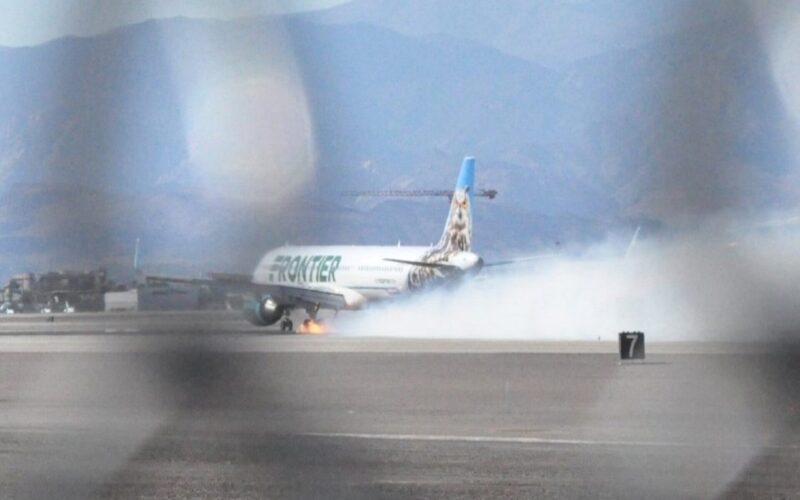Frontier Airlines crew members reported a chemical smell that became increasingly pungent before an emergency landing at Harry Reid International Airport (LAS) in Las Vegas that resulted in a dramatic brake fire.
Details about the incident were released by the National Transport Safety Bureau (NTSB) in a preliminary report published on October 28, 2024, which suggested that the cause of the emergency may have been a fault in a fan unit that cools the avionics compartment.
The Frontier Airlines Airbus A321-200, registered N701FR, departed San Diego International Airport (SAN) on October 5, 2024, shortly after 15:00, with 170 passengers and seven crew onboard.
Just prior to descent, the chemical smell was detected in the forward section of the aircraft by cabin crew staff and then by the captain and the first officer in the cockpit.
The odor was initially described as “chemical and acrid in nature, or mildew-like” and evolved to smell like “burning rubber and/or petroleum products, such as plastics”.
Frontier flight 1326 from KSAN-KLAS just caught fire on landing at KLAS.
— Tyler (@TylerHerrick) October 5, 2024
I caught it on video as it landed pic.twitter.com/KGt1Asx3rv
Wearing their oxygen masks the captain turned to the quick reference handbook (QRH) to perform a checklist which helped establish there was no visible smoke in the cockpit or in the aircraft cabin.
The NTSB report said: “As they proceeded through the QRH checklist, the first officer noted that ‘aircraft systems began to degrade’ which included the unavailability of the autopilot and autothrottles. He recalled that it was unclear if the degradations were the ‘result of damage to equipment from a possible fire, or a result of systems isolations [specified] in the checklist[s]’.”
As the source of the odor could not be established, the electrical emergency configuration procedure was initiated. Both the captain and first officer acknowledged this would deploy the ram air turbine.
As a result, the display screens, radio, and transponder stopped functioning on the first officer’s side and control was moved to the captain’s side. The flight data recorder also lost power as part of the emergency procedure.
Working under an “increasingly hectic and stressful” situation the captain used outside visual references during the approach with the first officer calling out airspeeds, altitudes and configuration information.
As the Frontier A321 touched down on runway 26L at LAS a witness close by reported “two loud bangs in quick succession” due to the tires exploding.
“The tires exploded about 3 seconds after touchdown. Then there was a large screen of smoke behind them and fire around the tires,” the witness told the NTSB investigators.
Video captured of the landing supported the witness statement with flames clearly visible around the landing gear.
An emergency evacuation was judged to not be unnecessary after fire crews assured the flight crew the fire was extinguished. Passengers left the aircraft via stairs brought to the aircraft.
Post-incident investigation
A fan unit that cools the avionics compartment has been retained for further examination after an aircraft monitoring system flagged a fault around 20 minutes before the flight touched down at LAS.
While the cockpit voice recorder captured the flight, the flight data recorder lost power about nine minutes prior to landing as part of the electrical emergency configuration procedure.
The investigation continues and a full report on the incident will be published in due course.

